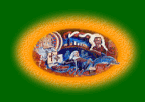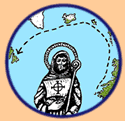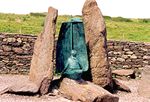 |
 |
 |
|
Legend states that Saint Brendan set sail from Cuas on a voyage across the North Atlantic. But there is more to Saint Brendan's famous quest for the 'Promised Land of the Saints' than mere legend.
In the 6th century AD groups of Christian monks began to make maritime pilgrimages from Ireland in naomhóga (curraghs) - light, seaworthy vessels made of greased animal hides stretched over a wooden frame, which could be rowed or sailed. Whilst some voyages were partly missionary in aim, the desire to seek island retreats where communities would be safe from war and persecution probably fired many of these perilous journeys. Irish monks reached the Orkneys in 579 AD, Shetlands in 620, and were first to discover the Faroe Islands about 670 AD and Iceland about 795 AD.
Brendan was born in the late 480's AD and educated at a missionary post at Ardfert in North Kerry before being ordained in 512 AD. He then went on to found a large number of ecclesiastical settlements. He was a pioneer seafaring missionary who travelled widely and crossed to the islands on the west coast of Scotland. Through such exploits he acquired the nickname 'the Navigator'.
The popular medieval account of Saint Brendan's voyage - Navigatio Sancti Brendani Abbatis - was written by clerics between 900 and 920 AD. In it, Brendan set sail with fourteen companions to search for the Promised Land in the west. They roamed the ocean for seven years, sometimes landing on extraordinary islands, until they reached their goal and explored inland. A youth appeared and told Brendan that he had indeed reached the borders of the Promised Land, which would one day become a haven from persecution for Christians. But meanwhile, he and his companions must return to the land of their birth, which they duly did.
 Navigatio indicates distance, direction
and climate, and gives descriptions of places visited
that strongly imply that the monks certainly reached
the Faroes and Iceland, and even encountered an
iceberg. Other references suggest that they also
visited St Kilda, Rockall, Greenland and the
Newfoundland Banks - and maybe even Madeira, the
Sargasso Sea, the Bahamas and Jamaica!
Navigatio indicates distance, direction
and climate, and gives descriptions of places visited
that strongly imply that the monks certainly reached
the Faroes and Iceland, and even encountered an
iceberg. Other references suggest that they also
visited St Kilda, Rockall, Greenland and the
Newfoundland Banks - and maybe even Madeira, the
Sargasso Sea, the Bahamas and Jamaica!
It is plausible that these Irish monks reached the shores of North America 500 years before the Vikings discovered 'Vinland' and 900 years before Christopher Columbus set foot on the 'New World'.
Whether or not they landed at Cuas, Brendan and the other monks did return safely home. The experience apparently did Brendan little harm: he lived until he was about 90 years old. He died in County Galway and is buried at Clonfert monastery.
In 1977, to test the feasibility of the voyage and the technology available to Brendan and other seafarers during the 6th century AD, a crew led by explorer Tim Severin set sail from Cuas harbour in a reconstruction of Saint Brendan's boat and successfully reached Newfoundland 13 months later.
 When you walk down to Cuas harbour from the
monument, and see the wooden framed, tarred canvas
naomhóga still in use by the local
fishermen, it is easy to imagine these intrepid and
hardy monks embarking on their voyage into the cold and
stormy seas.
When you walk down to Cuas harbour from the
monument, and see the wooden framed, tarred canvas
naomhóga still in use by the local
fishermen, it is easy to imagine these intrepid and
hardy monks embarking on their voyage into the cold and
stormy seas.